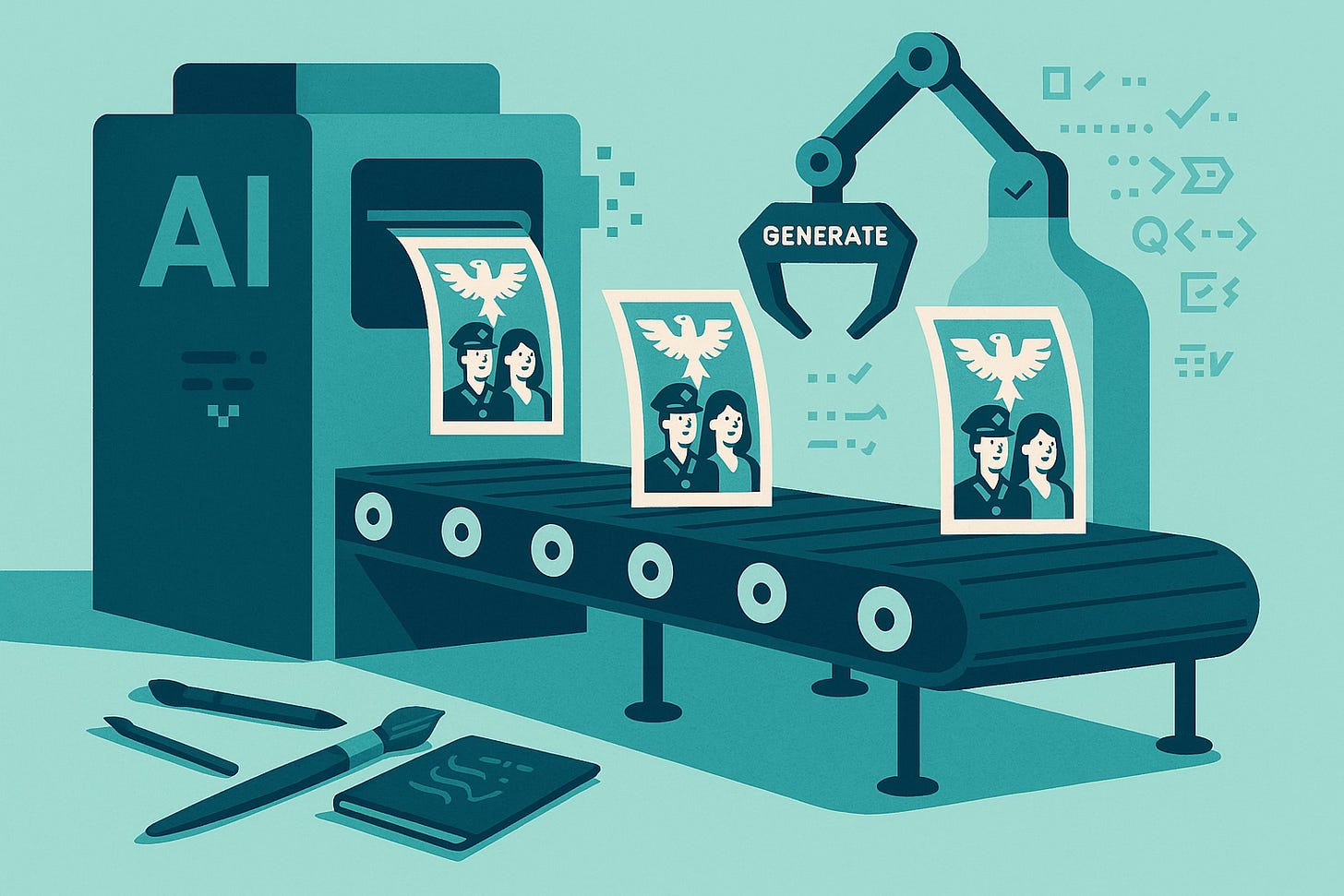Scroll, Click, Comply: How AI Slop Greases the Techno‑Fascism Gears
Here’s what technical writers can do about it
You know that reel where a chipper robot voice narrates a Reddit breakup over Subway Surfers footage? The one you swipe past while convincing yourself this is “research”? That’s not harmless background noise—it’s rehearsal footage for a political movement that prefers spectacle to substance and uniformity to thought.
RattleSnake Studio says it out loud in their video “AI Slop, Technofascism, and You.”
Watch this video on YouTube and share it with others.
AI Slop, Technofascism, and You
Wait—what exactly is “AI slop”?
AI slop is mass‑produced, low‑effort, AI‑generated junk—text, video, images—optimized for engagement metrics, not truth or usefulness. Think of it as content feedlot runoff: plenty of volume, zero nutrition.
Tech reporters and search pros are already using the term to describe the flood of machine-made filler clogging social and search results.
Fascism Runs on Aesthetics And AI Delivers Aesthetic-On-Demand
Walter Benjamin warned that fascism “aestheticizes politics”—it gives people goosebumps instead of rights. It turns power into a pageant while leaving the power structure intact.
Historically, fascist regimes curated a narrow visual vocabulary—heroic bodies, pastoral nostalgia, mythic pasts—and censored or criminalized artists who colored outside the lines. The Nazis literally staged a “Degenerate Art” show to ridicule work that didn’t fit the template, while centralizing “acceptable” imagery through a propaganda ministry.
Enter generative AI: a machine built to remix templates and crank out nostalgic pastiches at scale.
Uniformity? Check.
Backward-looking mythos? Easy.
Speed over nuance? Built in.
No need to wrangle opinionated artists with pesky ethics when you can just prompt your way to a thousand glossy Rockwell knockoffs, extra fingers included.
But I Write Release Notes, Not Manifestos, So, Why Should I Care?
Because documentation is how organizations tell the truth about what their products do, what users can and can’t do, what’s broken, and what’s at stake. When low-effort AI slurry seeps into doc sets, you don’t just annoy readers—you erode trust, blur authorship, and normalize myth-making. Your style guide becomes a speed bump, not a guardrail.
Authoritarian movements don’t just target “capital A” Artists. They go after anyone who controls narratives, defines terms, or keeps receipts. That’s you.
1. Provenance or it didn’t happen
Bake source, authorship, and review metadata into your content model. Who wrote it, who reviewed it, what model (if any) helped, when it was last fact-checked—make that machine-readable and auditable.
2. Institute an “AI Slop Check”
Before you ship anything generated or assisted by AI, ask:
Does this add anything new, or just remix clichés?
Can every factual claim be traced to a verifiable source?
Can I point to a human who stands behind this? If the answer is “uhhh,” you’re looking at slop. Fix it or kill it.
3. Document reality, not just requirements
The RattleSnake video urges creatives to connect the personal and the political, to show real human stakes. In docs, that means capturing actual user scenarios, edge cases, and consequences—not just the happy path marketing wants. Propaganda loves a vacuum; fill it with verifiable detail.
4. Myth filters in your workflow
Structured authoring plus governance = fewer unsupported claims. Require citations or subject matter expert sign-off for every “we’re the first,” “industry-leading,” or “everyone knows” sentence. Schedule periodic audits for marketing creep.
5. Teach your team to spot the tells
Host short, repeatable trainings on:
Common AI artifacts (those weird hands, uncanny phrasings, generic “inspirational” tone)
How deepfakes and synthetic text spread
Your internal rules for when AI is allowed and how it’s disclosed
6. Keep the hope (and humor) alive
Fascism’s endgame is compliance through despair. Authentic voice, honest status pages, and humane UX writing keep readers oriented—and remind them humans are still in the loop. That matters more than you think.
A Quick (And Reusable) Pre‑Publish Checklist
Human in the loop? Named reviewer approved it
Source trail visible? Every fact has a link you’d defend in public
Original value? Solves a user problem, not just fills a Jira ticket
Model disclosure? Which tools were used, and how
Inclusive & accurate? No in‑group mythologizing, no nostalgia gloss
Versioned? Easy rollback if an “auto-improve” feature degrades meaning
Copy, paste, stick it in your CMS workflow. Tattoo it on your product owner if necessary.
The Takeaway
AI isn’t evil. And, slop isn’t inevitable. But fascism loves a shortcut, and generative tech hands it the keys: infinite spectacle, zero accountability. Our counter is boringly heroic: receipts, rigor, reality—told by humans, for humans.
Keep making real human documentation. Keep telling true stories. Keep that pilot light on. 🤠





What a great little piece!! Thank you. I also appreciate the recommendation of the new YouTuber at the beginning of your post. He's great. And you know what? This article can easily be adapted for other audiences, like first-year writing students. I am excited to share this with my students in the fall semester.
I had no idea I could fight fascism with tech doc. Scott has enlightened me. I feel my consciousness has been raised. And I can use all the consciousness I can get 😉
Seriously, thank you for making such important points while we're about to be overwhelmed by slop and watch the internet become a tragedy of the commons, a dumping ground for toxic waste and junk food of the mental type. And take a look at the work of Ted Gioia here on Substack (The Honest Broker).
We need human supervision of the tools, which should be properly used for human purposes. Provenance, governance, and transparency are never a bad idea.